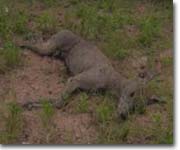 The chupacabras (Spanish pronunciation: [tʃupaˈkaβɾas], from chupar “to suck” and cabra “goat”, literally “goat sucker”), is a legendary cryptid rumored to inhabit parts of the Americas. It is associated more recently with sightings of an allegedly unknown animal in Puerto Rico (where these sightings were first reported), Mexico, and the United States, especially in the latter’s Latin American communities. The name comes from the animal’s reported habit of attacking and drinking the blood of livestock, especially goats. Physical descriptions of the creature vary. Eyewitness sightings have been claimed as early as 1990 in Puerto Rico, and have since been reported as far north as Maine, and as far south as Chile. It is supposedly a heavy creature, the size of a small bear, with a row of spines reaching from the neck to the base of the tail. Biologists and wildlife management officials view the chupacabras as a contemporary legend.
The chupacabras (Spanish pronunciation: [tʃupaˈkaβɾas], from chupar “to suck” and cabra “goat”, literally “goat sucker”), is a legendary cryptid rumored to inhabit parts of the Americas. It is associated more recently with sightings of an allegedly unknown animal in Puerto Rico (where these sightings were first reported), Mexico, and the United States, especially in the latter’s Latin American communities. The name comes from the animal’s reported habit of attacking and drinking the blood of livestock, especially goats. Physical descriptions of the creature vary. Eyewitness sightings have been claimed as early as 1990 in Puerto Rico, and have since been reported as far north as Maine, and as far south as Chile. It is supposedly a heavy creature, the size of a small bear, with a row of spines reaching from the neck to the base of the tail. Biologists and wildlife management officials view the chupacabras as a contemporary legend.
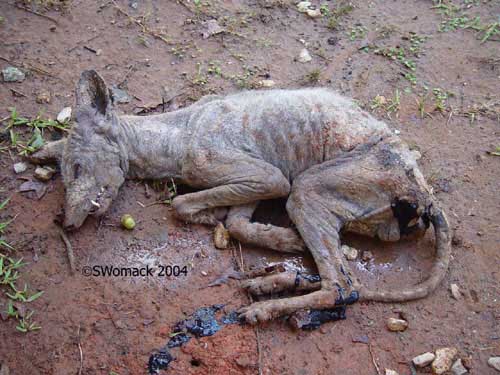 History
History
The first reported attacks occurred in March 1995 in Puerto Rico. In this attack, eight sheep were discovered dead, each with three puncture wounds in the chest area and completely drained of blood. A few months later, in August, an eyewitness, Madelyne Tolentino, reported seeing the creature in the Puerto Rican town of Canóvanas, when as many as 150 farm animals and pets were reportedly killed. In 1975, similar killings in the small town of Moca, were attributed to El Vampiro de Moca (The Vampire of Moca). Initially it was suspected that the killings were committed by a Satanic cult; later more killings were reported around the island, and many farms reported loss of animal life. Each of the animals had their bodies bled dry through a series of small circular incisions.
Puerto Rican comedian and entrepreneur Silverio Pérez is credited with coining the term chupacabras soon after the first incidents were reported in the press. Shortly after the first reported incidents in Puerto Rico, other animal deaths were reported in other countries, such as the Dominican Republic, Argentina, Bolivia, Chile, Colombia, Honduras, El Salvador, Nicaragua, Panama, Peru, Brazil, United States, and Mexico.
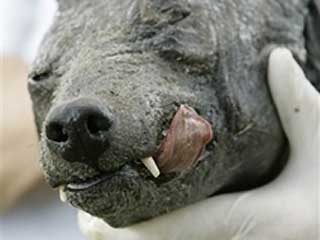 Reported sightings
Reported sightings
In July 2004, a rancher near San Antonio, Texas, killed a hairless dog-like creature, which was attacking his livestock. This animal, initially given the name the Elmendorf Beast, was later determined by DNA assay conducted at University of California, Davis to be a coyote with demodectic or sarcoptic mange. In October 2004, two more carcasses were found in the same area. Biologists in Texas examined samples from the two carcasses and determined they were also coyotes suffering from very severe cases of mange. In Coleman, Texas, a farmer named Reggie Lagow caught an animal in a trap he set up after the deaths of a number of his chickens and turkeys. The animal was described as resembling a mix of hairless dog, rat, and kangaroo. Lagow provided the animal to Texas Parks and Wildlife officials for identification, but Lagow reported in a September 17, 2006 phone interview with John Adolfi, founder of the Lost World Museum, that the “critter was caught on a Tuesday and thrown out in Thursday’s trash.”
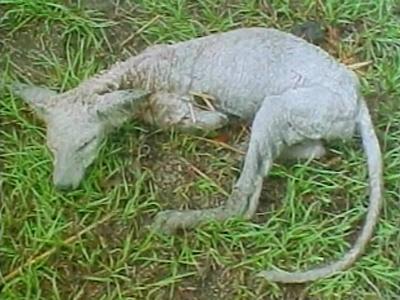 In April 2006, MosNews reported that the chupacabras was spotted in Russia for the first time. Reports from Central Russia beginning in March 2005 tell of a beast that kills animals and sucks out their blood. Thirty-two turkeys were killed and drained overnight. Reports later came from neighboring villages when 30 sheep were killed and had their blood drained. Finally, eyewitnesses were able to describe the chupacabras. In May 2006, experts were determined to track the animal down.
In April 2006, MosNews reported that the chupacabras was spotted in Russia for the first time. Reports from Central Russia beginning in March 2005 tell of a beast that kills animals and sucks out their blood. Thirty-two turkeys were killed and drained overnight. Reports later came from neighboring villages when 30 sheep were killed and had their blood drained. Finally, eyewitnesses were able to describe the chupacabras. In May 2006, experts were determined to track the animal down.
In mid-August 2006, Michelle O’Donnell of Turner, Maine, described an “evil looking” rodent-like animal with fangs that had been found dead alongside a road. The animal was apparently struck by a car, and was unidentifiable. Photographs were taken and witness reports seem to be in relative agreement that the creature was canine in appearance, but in widely published photos seemed unlike any dog or wolf in the area. Photos from other angles seem to show a chow- or akita-mixed breed dog. It was reported that “the carcass was picked clean by vultures before experts could examine it”. For years, residents of Maine have reported a mysterious creature and a string of dog maulings.
In May 2007, a series of reports on national Colombia news reported more than 300 dead sheep in the region of Boyaca, and the capture of a possible specimen to be analyzed by zoologists at the National University of Colombia.
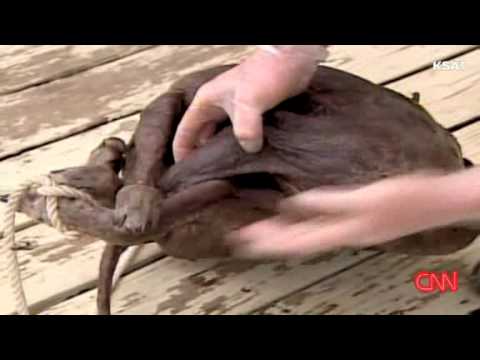 In August 2007, Phylis Canion found three animals in Cuero, Texas. She and her neighbors reported to have discovered three strange animal carcasses outside Canion’s property. She took photographs of the carcasses and preserved the head of one in her freezer before turning it over for DNA analysis. Canion reported that nearly 30 chickens on her farm had been exsanguinated over a period of years, a factor which led her to connect the carcasses with the chupacabras legend. State Mammologist John Young estimated that the animal in Canion’s pictures was a Gray Fox suffering from an extreme case of mange. In November 2007, biology researchers at Texas State University–San Marcos determined from DNA samples that the suspicious animal was a coyote. The coyote, however, had grayish-blue, mostly hairless skin and large fanged teeth, which caused it to appear different from a normal coyote. Additional skin samples were taken to attempt to determine the cause of the hair loss.
In August 2007, Phylis Canion found three animals in Cuero, Texas. She and her neighbors reported to have discovered three strange animal carcasses outside Canion’s property. She took photographs of the carcasses and preserved the head of one in her freezer before turning it over for DNA analysis. Canion reported that nearly 30 chickens on her farm had been exsanguinated over a period of years, a factor which led her to connect the carcasses with the chupacabras legend. State Mammologist John Young estimated that the animal in Canion’s pictures was a Gray Fox suffering from an extreme case of mange. In November 2007, biology researchers at Texas State University–San Marcos determined from DNA samples that the suspicious animal was a coyote. The coyote, however, had grayish-blue, mostly hairless skin and large fanged teeth, which caused it to appear different from a normal coyote. Additional skin samples were taken to attempt to determine the cause of the hair loss.
On January 11, 2008, a sighting was reported at the province of Capiz in the Philippines. Some of the residents from the barangay believed that it was the chupacabras that killed eight chickens. The owner of the chickens saw a dog-like animal attacking his chickens.
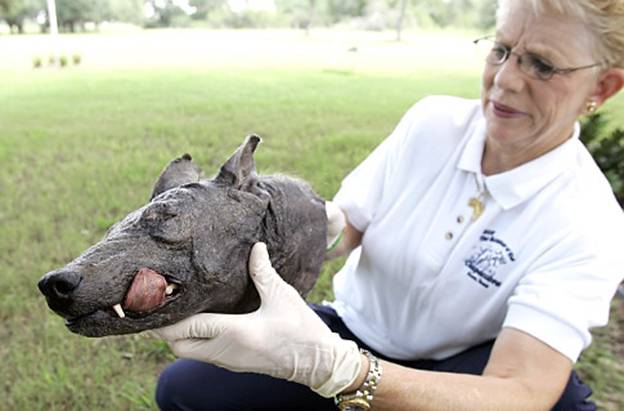 On August 8, 2008, a DeWitt County deputy, Brandon Riedel, filmed an unidentifiable animal along back roads near Cuero, Texas on his dashboard camera. The animal was about the size of a coyote but was hairless with a long snout, short front legs and long back legs. However, Reiter’s boss, Sheriff Jode Zavesky, believes it may be the same species of coyote identified by Texas State University–San Marcos researchers in November 2007.
On August 8, 2008, a DeWitt County deputy, Brandon Riedel, filmed an unidentifiable animal along back roads near Cuero, Texas on his dashboard camera. The animal was about the size of a coyote but was hairless with a long snout, short front legs and long back legs. However, Reiter’s boss, Sheriff Jode Zavesky, believes it may be the same species of coyote identified by Texas State University–San Marcos researchers in November 2007.
In September 2009, CNN aired a report showing closeup video footage of an unidentified dead animal. The same CNN report stated that locals have begun speculating the possibility that this might be a chupacabras. A Blanco, Texas, taxidermist reported that he received the body from a former student whose cousin had discovered the animal in his barn, where it had succumbed to poison left out for rodents. The taxidermist expressed his belief that this is a genetically mutated coyote.
On September 18, 2009, Taxidermist, Jerry Ayer, sold the Blanco Texas Chupacabra to the Lost World Museum. The museum, as reported in the Syracuse Post Standard on 9/26/09, is placing the creature on display as they work with a unnamed university to have the remains tested.
In July 2010, there were reports of chupacabras being shot dead by animal control officers in Hood County, Texas. A second creature was also reportedly spotted and killed several miles away. However, an officer of Hood County animal control said Texas A&M University scientists conducted tests and identified the corpse as a “coyote-canine hybrid” with signs of mange and internal parasites. The second reported chupacabra, shot July 9 about 8 miles south of Cresson, was eaten by vultures before it could be taken for testing.
Appearance
The most common description of chupacabras is a reptile-like being, appearing to have leathery or scaly greenish-gray skin and sharp spines or quills running down its back. This form stands approximately 3 to 4 feet (1 to 1.2 m) high, and stands and hops in a similar fashion to a kangaroo. In at least one sighting, the creature was reported to hop 20 feet (6 m). This variety is said to have a dog or panther-like nose and face, a forked tongue, and large fangs. It is said to hiss and screech when alarmed, as well as leave behind a sulfuric stench. When it screeches, some reports assert that the chupacabras’ eyes glow an unusual red which gives the witnesses nausea.
Another description of chupacabras, although not as common, describes a strange breed of wild dog. This form is mostly hairless and has a pronounced spinal ridge, unusually pronounced eye sockets, fangs, and claws. It is claimed that this breed might be an example of a dog-like reptile. Unlike conventional predators, the chupacabras is said to drain all of the animal’s blood (and sometimes organs) usually through three holes in the shape of an upside-down triangle or through one or two holes.
Significant appearances in media
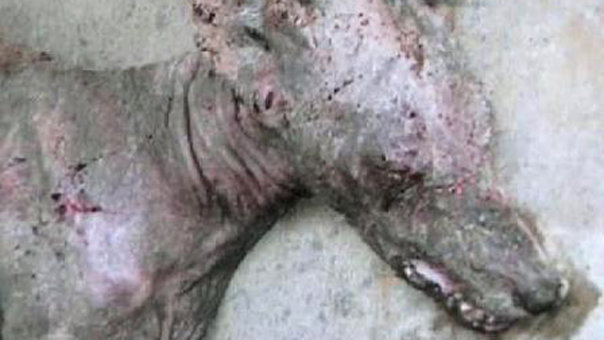 The popularity of the chupacabras has resulted in it being featured in several types of media. Some mystery novels that use aspects of the myth as the centerpoint of the plot have been published. Other kinds of books include those that provide a scientific explanation for the phenomena. The chupacabras has been featured in films such as Scooby-Doo and the Monster of Mexico and in independent film productions including: Chupacabra: Dark Seas, starring John Rhys-Davies, Guns of El Chupacabra, starring Scott Shaw, El Chupacabras and Vuelve el Chupacabras.[citation needed]. Welsh rock band Super Furry Animals have a song on the 1997 album “Radiator” called “Chupacabras”. An entire episode of The X-Files series, El Mundo Gira, is devoted to the chupacabras. A whole segment in Dexter’s Laboratory is for the chupacabras in the episode called “Got Your Goat” from the Season 2. It has also been portrayed various times in the anime series Negima!?.
The popularity of the chupacabras has resulted in it being featured in several types of media. Some mystery novels that use aspects of the myth as the centerpoint of the plot have been published. Other kinds of books include those that provide a scientific explanation for the phenomena. The chupacabras has been featured in films such as Scooby-Doo and the Monster of Mexico and in independent film productions including: Chupacabra: Dark Seas, starring John Rhys-Davies, Guns of El Chupacabra, starring Scott Shaw, El Chupacabras and Vuelve el Chupacabras.[citation needed]. Welsh rock band Super Furry Animals have a song on the 1997 album “Radiator” called “Chupacabras”. An entire episode of The X-Files series, El Mundo Gira, is devoted to the chupacabras. A whole segment in Dexter’s Laboratory is for the chupacabras in the episode called “Got Your Goat” from the Season 2. It has also been portrayed various times in the anime series Negima!?.
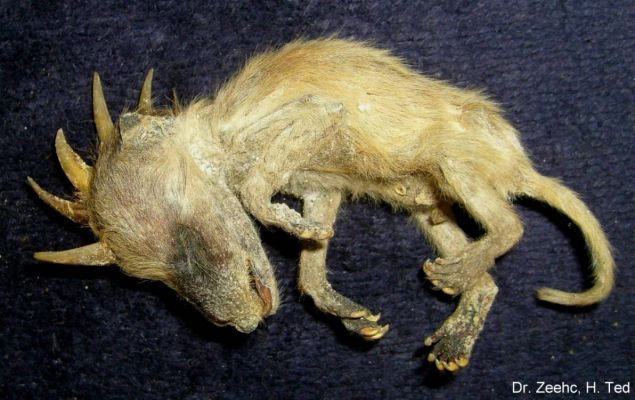 CNN’s Ed Lavandera has described the chupacabras as the “Bigfoot of Latino culture” and has stated that “El Chupacabra also symbolizes the fear of something that doesn’t exist”. Following the incident in Cuero, Texas the popularity of the chupacabras myth was receiving global attention. Phylis Canion, who was responsible for capturing the alleged specimen, claimed that t-shirts highlighting the event were shipped to locations such as Italy, Guam, and Iraq. The publicity that Cuero received following this event has led to some suggesting changing the town’s mascot. In July 2008, History’s Monster Quest series featured the Texas carcasses, which were determined to be dogs and coyotes.
CNN’s Ed Lavandera has described the chupacabras as the “Bigfoot of Latino culture” and has stated that “El Chupacabra also symbolizes the fear of something that doesn’t exist”. Following the incident in Cuero, Texas the popularity of the chupacabras myth was receiving global attention. Phylis Canion, who was responsible for capturing the alleged specimen, claimed that t-shirts highlighting the event were shipped to locations such as Italy, Guam, and Iraq. The publicity that Cuero received following this event has led to some suggesting changing the town’s mascot. In July 2008, History’s Monster Quest series featured the Texas carcasses, which were determined to be dogs and coyotes.
A character modeled after the chupacabras appears in the podcast Strange Fairy Tales. He was first introduced in the twenty-second episode which was done entirely in Spanish. The chupacabra was almost arrested for stealing the blood of little goats, but he gave it back, and was then hired as the Foreign Relations Man of Strange Fairy Tales.
Naming convention
Chupacabras can be translated as “goat-sucker.” It is known as both chupacabras and chupacabra throughout the Americas, with the former being the original word, and the latter a regularization of it. The name in Spanish can be preceded by singular masculine article (el chupacabras), or the plural masculine article (los chupacabras).
Did you know that if you subscribe to our website, you will receive email notifications whenever content changes or new content is added.
1. Enter your e-mail address below and click the Sign Me Up button.
2. You will receive an email asking you to confirm your intention of subscribing to our site.
3. Click the link in the email to confirm. That’s all there is to it! Note: if you wish to unsubscribe from our site, click the unsubscribe link at the bottom of the email you received.
Then indicate you no longer wish to receive our emails.
Thank You
Prisonbreakfreak.com Team
